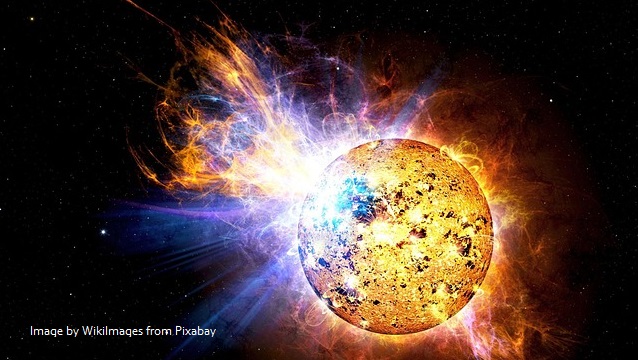Understanding Solar Flares and What They Can Do To Us
By Amil Imani

The sun, our life-giving star, is a dynamic ball of constantly changing plasma. Among the most spectacular phenomena it produces are solar flares, intense bursts of light, and energetic radiation that erupt from its surface. While these events capture our imagination, they also raise concerns.
Solar flares originate in the sun’s atmosphere, specifically in regions with intense magnetic activity. These areas, known as “sunspots,” exhibit complex interactions among magnetic fields, leading to the sudden release of enormous amounts of energy. This energy manifests as intense radiation across various wavelengths, including visible light, ultraviolet light, X-rays, and gamma rays. Additionally, solar flares can propel streams of charged particles into space, known as coronal mass ejections (CMEs).
Fortunately, Earth possesses several natural barriers that protect us from the brunt of solar flares. Our planet’s magnetic field acts as a shield, deflecting most harmful radiation and charged particles. The atmosphere further filters out a significant portion of the remaining radiation. However, this protection could be better, and the intensity of a solar flare can determine the extent of its impact.
Solar activity exhibits cyclical patterns, with periods of high and low activity. The sun is in the rising phase of its 11-year cycle, which means that an increased frequency of solar flares can be expected in the coming years. While most flares are relatively minor, large flares can trigger a cascade of effects on Earth.
Radio blackouts: Intense X-rays can temporarily disrupt radio communications, impacting air traffic control, navigation systems, and emergency services.
Power grid disruptions: Induced currents in power grids due to geomagnetic storms can cause transformer failures and widespread blackouts.
Satellite malfunctions: Energetic particles can damage sensitive electronics aboard satellites, impacting GPS navigation, communication networks, and scientific observations.
Aurora borealis and australis: Increased charged particles create stunning auroral displays but pose radiation risks to astronauts and high-altitude aircraft.
Solar flares are indeed powerful events. However, while they are a natural phenomenon we should be aware of, it’s important to maintain perspective and not let fear overwhelm us. Here are some key points to consider:
Solar superflares are rare: While observed on other stars, superflares from our sun are highly uncommon. Evidence suggests that the sun experiences powerful flares roughly every 10,000 years, and even those may not be as devastating as the worst-case scenarios depict.
Scientific warning: Solar activity is closely monitored, and scientists would likely anticipate a superflare with some lead time. This allows for potential mitigation measures like shutting down power grids to minimize damage.
How to prepare: Although complete protection might not be feasible, taking steps like hardening critical infrastructure, developing backup systems, and raising awareness can still significantly reduce the impact.
Not everything dies: Even in a worst-case scenario, the extent of the damage would depend on the characteristics of the flare and our preparedness. Life might persist in sheltered areas, and the planet would eventually recover.
Focus on what you can control: Instead of dwelling on worst-case scenarios, let us focus on actions that empower. Staying informed about solar activity is one; supporting efforts to improve preparedness is an extra step. Advocating for resilient infrastructure should be a continuous effort.
Understanding and predicting solar flares is crucial for minimizing their impact. International organizations like NOAA closely monitor solar activity and issue timely warnings of impending events. This allows critical infrastructure operators to take precautionary measures, such as switching to backup power systems or shielding sensitive equipment.
Research into space weather forecasting and mitigation technologies is ongoing, aiming to better predict and defend against future solar storms.
From understanding their mechanisms to mitigating potential effects, proactive preparedness remains vital in confronting the challenges posed by solar flares. This ensures a more resilient future where our planet and its technological infrastructure can weather these natural phenomena.
We should do everything to approach this issue with informed caution and proactive solutions.
As an end note, this post only briefly overviews solar flares and their effects. Please refer to authoritative sources like NOAA’s Space Weather Prediction Center for the latest information and warnings.
Copyright 2024. Amil Imani. All rights reserved.
RELATED ARTICLE: Bill Gates’ Dark Dream of Blocking Sunlight from the Earth is About to be Realized

This article is courtesy of DrRichSwier.com, an online community of citizen journalists, academics, subject matter experts, and activists to express the principles of limited government and personal liberty to the public, to policy makers, and to political activists. Please visit DrRichSwier.com for more great content.

